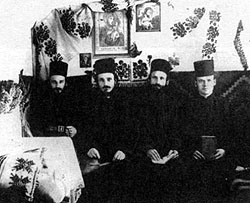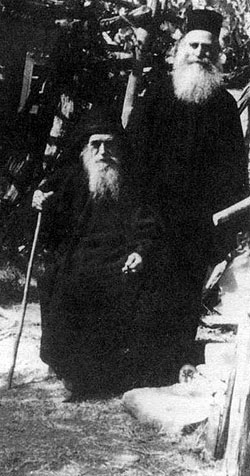Monk Gedeon of Kolitsou
30 August 2014He was born in Gadintsi, Moldavia (Romania), in 1894, into a Christian family, and his name was Gheorghe [George] Chelaru. His father, Constantine, was a reader at the local church. He attended the first four classes at the school in his village. After this he served at the palace of Prince Bogdan and then went on to do four years of military service as a sergeant and secretary. By God’s grace, he was one of the few who survived the Forst World War.

The fathers from Kelli of Saint Tikhon, Kapsala, 1932
In 1920 he left for the Holy Mountain, arriving at the Kelli of Saint George in Kapsala, where he lived as a disciple of Elder Gerasimos. In 1925 he was tonsured as a monk with the name of Gedeon. Thereafter, he returned to Romania to raise funds for his kelli and remained there for four years. He returned with a great deal of money and very many names for commemoration, which he gave to his Elder. With his Elder’s blessing, he moved, in 1929, to the kelli of Saint Tykhon. Shortly afterwards, he became linked to the brothers Gymnasios († 1965) and Dionsysios (†2004), who were living in great poverty and gladly became his disciples, in 1933, along with eight other monks.

Elder Gedeon with disciple Dionysios
In 1937, the brotherhood moved to the [Vatopaidan] Kelli of Saint George at the Skete of Kolçu, which, with enormous effort and at great expense, they renovated and added necessary extensions. Elder Gedeon went to Romania again in 1940, on another fund-raising trip, but, once again, the country was at war. He suffered terribly, first, at the hands of the German army and then, of the Communists. He managed to return to his kelli in 1963, weak and ill, but with a treasury of spiritual riches. In his last five years, Elder Gedeon was very ill. He stayed in his cell, reading the psalter and singing hymns. He was a spiritual treasure for the Holy Mountain, an important Athonite starets. He observed his rule assiduously and called it ‘precious gold’. He avoided empty words, gossip and, above all, criticism, which is so hateful to God. He was always blessing, forgiving and consoling. His solution and aid in afflictions was the Mother of God, whose paraklisi [Canon of Intercession] he would often sing. The Jesus prayer was constantly on his lips.
Before his demise, he took Holy Communion more frequently. At the end, he was confined to bed and took communion there. On 28th of August 1979, Elder Dionysios went to the Monastery of Doheiariou, for a paraklisi for him before the wonder-working icon of the Mother of God Who is Swift to Hear. The next day, Elder Dionysios celebrated the Divine Liturgy and gave Holy Communion to Elder Gedeon. In the afternoon of 30th of August 1979, while he was praying, he went to his rest in the Lord, and was buried the next day in the grounds of his kelli.
***
I began going to the kelli of Saint George at Kolçu just a few years after Elder Gedeon went to his rest in the Lord. How times have changed. When Elder Gedeon and the others arrived, times were very hard indeed. Elder Dionysios told me that one of the reasons why his own brother, Gymnasios, passed away there relatively young was because conditions were harsh, they had to work so hard, and Gymnasios was uncompromising in his ascetic efforts. There is now a flourishing brotherhood (with a new Elder Dionysio, a Gymnasio and a Gedeon) and the Holy Monastery of Vatopaidi is extremely generous in providing for their needs. J.W. Lillie






